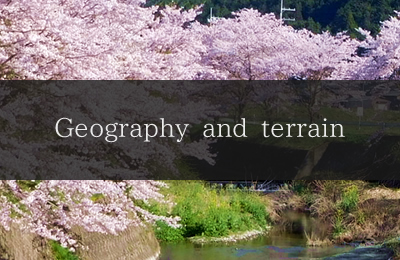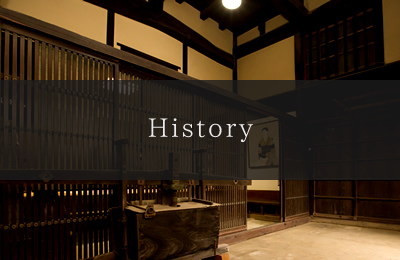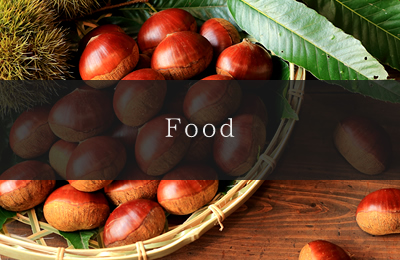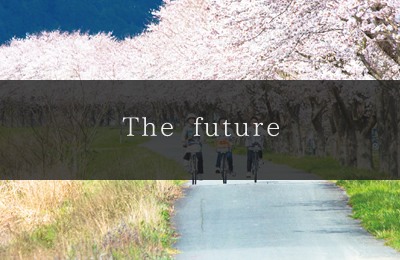What is the Hikami Kairo?
Food
Rich dietary culture created by a unique natural environment.
The climate produced by the Hikami Kairo and the human activity created fertile soil that makes anything delicious, including Tamba dainagon adzuki beans, Tamba chestnuts, and Tamba black soybeans, as well as rich culture.
Abundant water and Tamba‐Giri (Tamba mist)
The area around Tamba City where the north and south climates converge thrived long ago as a place where delicious crops grow thanks to the blessings of abundant snow and rain.
Also, the temperature difference between night and day in spring and autumn creates a deep mist.
This thick milky-white mist called ‘Tamba‐Giri’ envelops the forests and fields that tend to dry out in autumn with moisture that is essential for growing large and lustrous adzuki beans and black soybeans.
This moisture and the temperature difference are also said to be critical for matsutake mushrooms that are the flavor of autumn and help other crops like chestnuts, grapes, pears, and blueberries grow healthy and sweet.
Rich soil
It is thought that the lowland of the Hikami Kairo used to be a vast swamp before people began cultivating the area.
The rivers that flow in from the mountains brought rich soil to the skirts of the mountains. In the Hikami Kairo that is a lowland with an altitude of only 95 meters, the soil carried to the mountain skirts accumulated thickly along the gentle rivers producing diverse wildlife and rich soil.
Cultivated soil in the Tamba area is still considered to be very sticky and the rich fields there make everything grown in them delicious.
Tamba Sampo
Of the local Tamba City, Hyogo Prefecture specialties, Tamba considered its Tamba chestnuts, Tamba black soybeans, and Tamba dainagon adzuki beans the best in the country, giving these three products the collective name, ‘Tamba Sampo’ (the three treasures of TanbaTamba).
As the features of the Tamba Sampo, they are strongly flavored and relatively large thanks to Tamba’s unique climate, they are traditional products that were gifted to the imperial court and the Shogunate since long ago, and that the farmers are very selective and keep special techniques to grow them.
These products that are like treasures receive a lot of attention; they are shipped to other prefectures as ingredients without processing and they are also used in the production area itself, Tamba City, Hyogo Prefecture, in premium Japanese style and other confectionery.

The Tamba chestnuts grown in the Tamba area have been famous since long ago; story has it Empress Jito promoted its cultivation and it is mentioned in the Manyoshu (the first major anthology of early Japanese poetry), the Kojiki (records of ancient matters), and the Nihonshoki (chronicles of Japan). There are records showing that it was recognized by the government as a local specialty product and was given as payment in lieu of tax. Because they could even be exchanged at the market for silver, there is even a variety called Ginyose (“Gin” means silver in Japanese). While they are naturally sweet and delicious, they are also large and shiny and are currently highly rated in markets as a top end product. After the autumn harvest season, you will find many chestnut foods like Shibukawani (astringent skin of chestnut simmering), rice with chestnuts mixed in, and Japanese and Western-style desserts.

There is a record showing that, in 1705, Aoyama Tadashige who was the Tamba Kameyama feudal lord at the time (in what is currently Kameoka City, Kyoto Prefecture) said that there is no comparison for the adzuki beans produced in Tamba Province and Higashinaka, Kokuryo-mura (currently Higashinaka, Kasuga-cho, Tamba City, Hyogo Prefecture). The record says that these adzuki beans were chosen to be given to the Shogunate as a particularly excellent variety from among all those the Shoya (Edo era village headman) were required to submit. Some were even given to the imperial court. They are large and sweet and do not fall apart easily when boiled, and the story goes that they were called “dainagon adzuki beans” because they are compared to a dainagon (meaning chief councilor of state) who would not be killed by disembowelment even if he drew his sword in the palace. In Higashinaka, Kasuga-cho, Tamba City, Hyogo Prefecture that is the place of origin of Tamba dainagon adzuki beans, the Kurosaya variety of the beans that are the original variety have been re-introduced and top class Tamba dainagon adzuki beans are being grown as “Magical Tamba dainagon” beans, receiving much attention.

One major crop in Tamba is black soybean. The clay-like soil and air that is covered in mist in the morning and at night are perfect for growing soybeans. These black soybeans are large and shiny and are ranked highly at the market, and simmered black soybeans are an essential part of New Year’s dishes in Japan. Recently, they have also become extremely popular as edamame, soybeans harvested before they are ripe. Kuro-edamame are grown slightly after summer when the regular early maturing varieties come in season, and the Honguro type that is ready in October is delicious. During this season, they are sold in large quantities at roadside rest areas and farmer's markets around Tamba City.
Blessings of diverse wildlife
We must also not forget that it is the diverse wildlife that supports the fields without our noticing.
While the work of farmers is needed for vegetables and fruit to open their leaves the flowers to blossom, and bring forth fruit, assistance from the small living creatures and their interconnections are also essential.
The Hikami Kairo where the north and south climates intersect is a habitat for not only all types of wild vegetation, but also insects like honeybees and butterflies, small animals, small birds, hawks, owls, and other wildlife.
In years with a heavy snowfall, abundant rain, or drought, these wildlife compensate for each other’s weaknesses to save the harvest and have continued keeping people’s dinner tables rich with mountain vegetables, fruit, nuts, mushrooms, and other bounties from the mountains.
Even today, angelica tree buds, wild giant butterbur, bracken, and other mountain vegetables liven up the dinner tables of farmers in springtime, and the special local names of autumn mushrooms such as shirobon (gypsy mushroom) and nezumi-no-ashi (clustered coral) give us a sense of the rich satoyama culture.
Rich human interaction and the feudal lord’s special sweets delivery
The history of the people in the Tamba area goes back over 25,000 years, but the history of rice cultivation appears in many remains and records from the Yayoi period (about 100 BC) onward.
Cultivation of the large Tamba chestnuts that are used in Japanese- and Western-style confections also has a long history, and the Engishiki book of laws and customs (established in 927) that was a government document in the Heian period says that a large volume of chestnuts were given every year as Minie offerings and sweets to be used in the imperial court meals.
Still later, there are records of sweet chestnut farms in Kuritsukuri-no-sato, Hikami District. Records from the early Edo period often mention that Tamba chestnuts were large and high quality, and it is evident that they were delivered to not only Kyoto and Osaka, but also as far as Edo.
Not only did the people in the rural part of the Tamba area deliver crops to the government, but they also actively interacted with people in the surrounding areas. Each farmer in each village labored strenuously for their own crops, and they were also committed to breed improvement for the area that included villages and domains.
In 1705 in the early Edo period, Aoyama Tadashige, the first feudal lord of the Tamba-kameyama domain that ruled Tamba Province at the time (currently Kameoka City, Kyoto Prefecture), noticed that the adzuki beans from Higashinaka, Kokuryo-mura (currently Higashinaka, Kasuga-cho, Tamba City, Hyogo Prefecture) were top class. He carefully selected some beans and sent one shipment (equaling about 18 liters) to the fifth shogun, Tokugawa Tsunayoshi, receiving high praise. Tsunayoshi in turn gave the best beans to the imperial court, and the evaluation that they were unrivaled is how they got their name, ‘Tamba dainagon adzuki beans.’
Later, the Aoyama family was transferred to another province, but continued having adzuki beans delivered from Higashinaka, Kokuryo-mura every year to give to the shogunate until the end of Edo period. Because of this, a winter custom developed in the imperial court and the shogunate of looking forward to the delivery every year of the adzuki beans that were savored as a special sweets delivery.
The dietary culture in Tamba is a wonderful asset that combines the bountiful blessings of nature and the coming and going of people since long ago.














